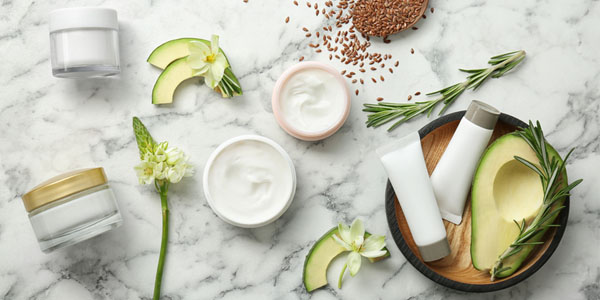While today’s consumers continue to show a preference to natural or naturally-derived products, they also see high efficiency as a must-have feature in cosmetic products. Simultaneously, end users look for solutions to new skin concerns, such as the harm from blue light and infrared radiation. To meet the demand, manufacturers shift their focus to more advanced product technologies, such probiotics, cell-derived actives, and neuro-cosmetics.
From your lunch to skin care routine: probiotics
Well-positioned on the food market, probiotics are now used to cultivate “skin-friendly” bacteria in cosmetic formulations, responding to aging and specific skin care concerns. Several cosmetics companies already offer probiotic-based skin care products. Aurelia Probiotic Skincare combines probiotic technology with ethically-sourced botanical formulations, aiming to boost cell metabolism. Tula Skincare Products is putting to use Multistrain Probiotic Technology, yogurt cultures, and nutritious superfoods to formulate its wide range of personal care products. Active ingredient manufacturer Sabinsa has developed a probiotic-based ingredient Lactospore, based on L (+) lactic acid, which is completely metabolized by glycogen.
While medical tests prove the effectiveness of probiotic-based products, there are still a few obstacles for cosmetics manufacturers. The basic challenge is to identify the right microorganism to be used in the formulation. Chemicals used in cosmetic formulations do not always provide the right medium to keep bacteria alive, and this may affect the viability and efficacy of the formulation. To prevent any undesirable reactions or excessive growth, the majority of probiotic-based cosmetic ingredients stick to formulations, where bacteria are present in a dormant state.
Towards the most natural and effective: marine ingredients and botanicals
The cosmetic industry has been using the diversity and unique benefits of marine ingredients for the last few decades. However, with the new cell and tissue systems recently developed by manufacturers, end-products dramatically increase in functionality and efficacy. In 2016, Seppic, through its BiotechMarine subsidiary, launched Celebrity, the world’s first technology to grow macroalgal cells in a laboratory, based on rare and valuable algae. The first ingredient produced through this technology is Ephemer, which provides an immediate and long-lasting antioxidant effect on cells. The second ingredient Contacicel is based on red alg and reduces the sebum of skin exposed to a polluted atmosphere.
Naturex has introduced Eutectys, a botanical extract collection, which aims to obtain biomimetic extracts with augmented phytoactive. The product line includes olive leaf, saffron flower, and horsetail, among others, serving as a natural alternative to conventional solvents. Evonik introduced TEGO Stemlastin, an extract of the micro algae Cyanidium caldarium, derived from stem cells.
New product categories, such as natural osmolytes, are now also being developed and used in cosmetic skin care and hair care applications. Osmolytes are compounds that regulate fluid balance and thus maintain cell volume. DuPont has developed a product range called GENENCARE OSMS, featuring naturally-sourced osmolytes for skin, hair, and color cosmetic applications. The product, derived from non-GMO sugar beet, consists of natural betaine and inositol as its constituents. Osmolytes have been found to be an excellent moisturizer through in-vitro and clinical tests and protects skin cells from dehydration and denaturation.
New concerns and expectations: blue light, infrared rays, and neurological stimulation
New application areas for botanical ingredients, such as blue light protection, infrared rays defense, and neurological stimulation, are gaining momentum, reflecting shifts in consumers’ lifestyles. An average person spends more time using electronic devices than sleeping. The blue light emitted from mobile devices, laptops, and PC monitors is damaging to skin cells and eventually accelerates the aging process. To respond to this concern, manufacturers have introduced products to protect the skin from blue light stress. Ashland has introduced Blumilight, a biofunctional product based on Theobroma Cocoa Seed extract used in defense creams, outdoor care, eye care, and other products. Blumilight aims to reduce the penetration of blue light rays under the skin by improving the activity of photoreceptors. Another concern related to the overuse of electronic devices is infrared rays. Radiation and heat damage the skin on a cellar level and cause aging in vivo. Croda/Sederma has introduced Venuceane, a new generation of protection from UV damage and IR-Aging, using a bio-based Thermus Thermophillus Ferment.
Consumers’ desire to balance their lives and improve their well-being has resulted in a growing interest for neuro-cosmetics. These products consist of anti-aging ingredients and special ingredients that work on the neurological level, producing a soothing effect with “feel good” chemicals. Neuro-cosmetics can prolong cell life and regulate inflammatory responses; on top of that, these products are suitable for people with sensitive skin. As the number of consumers intolerant to different chemicals grow, neuro-cosmetics offer new opportunities for ingredient suppliers. Happybelle-PE from Mibelle Biochemistry is an example of a biotechnology active containing a phyto-endorphin complex based on monk’s pepper. Key benefits include stimulation of cell activity, decrease in wrinkle depth, and better skin hydration. Indena has introduced a botanical neuro-cosmetic ingredient called Bosexil, a form of the triterpenoid acid fraction frankincense, proven to be effective against photo-aging.
Certainly, biofunctional ingredients now play an important role in the personal care market. With an estimated market size in Brazil, China, Europe, and the United States at about USD 1.1 billion, this market is expected to grow at a compound annual growth rate of over 6% during the forecast period from 2016 to 2021. The demand for natural but highly effective products, changes in end users’ lifestyles and preferences, as well as an ongoing desire to look younger, will be some of the key factors driving the market. To stay afloat, manufacturers need to put innovative, effective, and solutions on product shelves through extensive R&D and consumer analysis.
Learn more about advanced technologies, new product formulations, as well as the key trends on global skin care ingredients and specialty actives market with Kline’s just published report Specialty Actives in Personal Care: Multi-regional Market Analysis and Opportunities.

